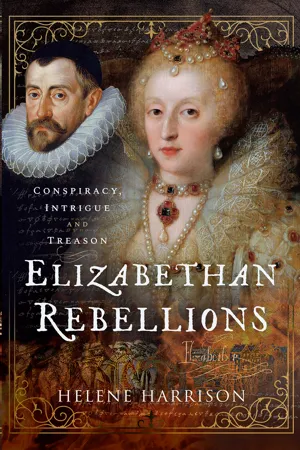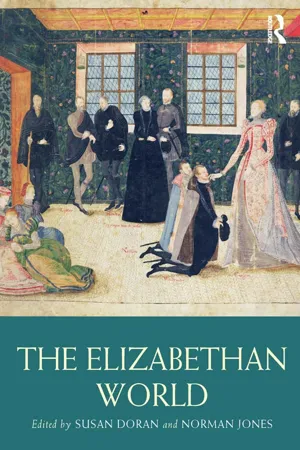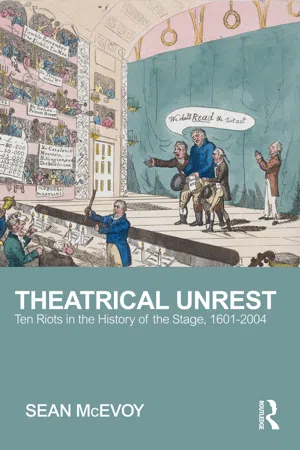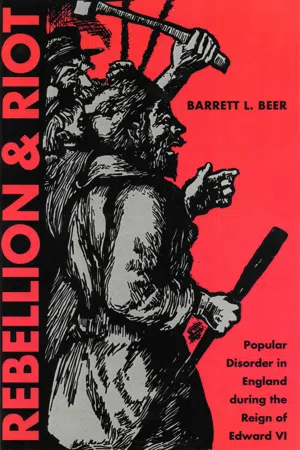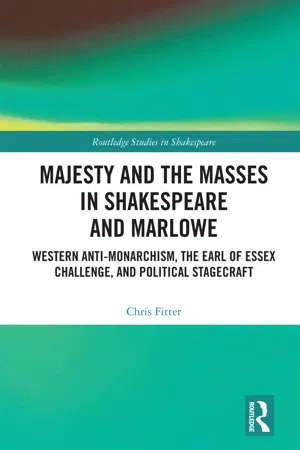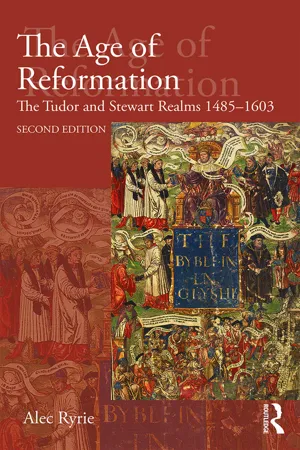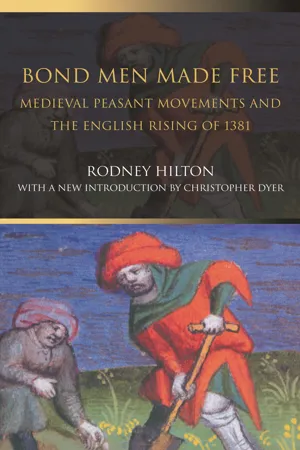History
Essex Rebellion
The Essex Rebellion was a failed coup attempt led by Robert Devereux, 2nd Earl of Essex, against Queen Elizabeth I of England in 1601. Essex sought to overthrow the queen's government due to his dissatisfaction with his own political standing. The rebellion was quickly suppressed, leading to Essex's capture, trial, and eventual execution.
Written by Perlego with AI-assistance
Related key terms
8 Key excerpts on "Essex Rebellion"
- eBook - ePub
Elizabethan Rebellions
Conspiracy, Intrigue and Treason
- Helene Harrison(Author)
- 2023(Publication Date)
- Pen and Sword History(Publisher)
Chapter 6Essex Rebellion 1601
‘What is allotted to us by destiny cannot be avoided’1The Essex Rebellion of 1601 is singular among Tudor rebellions and among most rebellions in English history. This is because it happened essentially for selfish reasons and the Earl of Essex’s overwhelming belief in his own importance. Rebellions more generally tend to have a political or economic aim. Robert Devereux, 2nd Earl of Essex, had lost the favour of Elizabeth I, having been her favourite since the death of Robert Dudley, 1st Earl of Leicester, in 1588. It had been suggested at the beginning of her reign that Elizabeth might marry Leicester, but it never happened. Perhaps Essex reminded her of this youthful dalliance. Essex was also a tenuous link to Leicester, as Leicester had married Essex’s mother after the death of her first husband. Essex had lost sight of the fact that Elizabeth was a queen, ruler, and monarch first, and a woman second. He did not treat her with the respect due to her rank, but as an equal. This upset Elizabeth’s equilibrium and her sense of her own majesty.Essex’s failure in Ireland in 1599 was the straw that broke the relationship completely. Essex had had ups and downs with the queen as he had been involved with several failed military and exploratory expeditions over the previous few years. He had also married in secret Frances Walsingham in 1590, the daughter of Elizabeth’s spymaster, Sir Francis Walsingham, and the widow of Sir Philip Sidney. Essex was one of only two councillors in Elizabeth’s reign to be executed. The other was Thomas Howard, 4th Duke of Norfolk, who was executed in 1572 after the failed Ridolfi Plot the previous year. Elizabeth’s reluctance to execute is demonstrated in the fact that, of all rebellions, only two of her councillors were executed despite several being implicated. Possibly Elizabeth remembered her own time in the Tower under threat of execution, or the fate of her mother, Anne Boleyn. She seems to have avoided executing her nobility if she could help it, and Essex was no exception, but she did capitulate in the end when faced with incontrovertible proof. - eBook - ePub
- Susan Doran, Norman Jones, Susan Doran, Norman Jones(Authors)
- 2014(Publication Date)
- Routledge(Publisher)
10 And indeed, despite the many hardships of the Elizabethan years posed by demographic explosion, religious reformation and, in the later years, near constant warfare, rebellion was rare. There was an abundance of riot and much criminal disorder, but almost no mass revolts during Elizabeth’s long reign. Certainly, a few people tried. Steer’s attempt is reasonably well recorded, thanks to the legal innovations it inspired, but other efforts are often known only by passing references in the pardon rolls, assize files or state papers. Some carpenters, weavers and husbandmen did, like Steer, preach rebellion to market-day crowds or alehouse gatherings of people with deeply felt grievances, but, like Steer, few got very far. Despite the authorities’ fears of vagrant armies overthrowing all order and of petty criminals banding together to destroy the State, no truly popular rebellions transpired.Even elite conspirators, with better resources and more social capital at hand, rarely managed to move from conspiracy to effective action. The abortive coup led by the Earl of Essex in January 1601 is the best-known case in point. Essex had long been the Queen’s well-rewarded favourite, using the gifts she bestowed to cultivate a sizeable clientele. His largesse and profligacy left him in hard financial straits when the royal bounty ended. With that, his thwarted ambition and injured pride motivating him, Essex gathered his aristocratic followers to seize the Queen. When bemused Londoners offered no help, the attempt collapsed, and Essex died a traitor’s death. The scarcity of rebellion in this era stands in marked contrast to the many armed protests that bedevilled Elizabeth’s predecessors and is often cited as further proof of Elizabeth’s acumen and good governance. Yet, given that there were discontents – and discontented persons – aplenty, one must ask whether Elizabeth kept her subjects better contented or better controlled.A brief examination of the one serious rebellion that did take place in Elizabethan England, the Northern Rising of 1569, might suggest answers. There had already been several serious riots that year. In Derbyshire, a group of men had armed themselves, camped on disputed land and associated with a man suspected to be peddling political prophecies, which were always feared by the authorities for their radicalising potential. In Cumberland, a group, variously estimated at 300 to 400 or 1,000 strong, destroyed the enclosures in a local forest and had as one of their leaders a man wanted for ‘his notorious abusing of the Queen’s Majesty’s name and authority’; the authorities took their efforts seriously enough to try charging many of them with felony. In Suffolk, disruptions in the cloth trade prompted some to rise against foreign workers and, according to one alarmed local JP, ‘to have spoiled all the gentlemen and worthy personages that they might overtake … and so marching towards London, to have provoked with this example the whole realm to the like uproar’.11 The confession of one man confirmed the seriousness of the plotters’ intent. James Fuller, a Suffolk sawyer, said that he and others had planned to rebel for lack of work or money. Once they had rung the bells to gather men, they planned to ‘proceed and bring down [the] price of all things at our pleasure’. He had pledged his fellow plotters that this time, ‘we will not be deceived as we were at the last rising, for then we were promised enough. But the more was a halter. But now we will appoint them that shall take the rich churls and set them on their horsebacks under a tree … and so let them hang.’12 - eBook - ePub
Theatrical Unrest
Ten Riots in the History of the Stage, 1601-2004
- Sean McEvoy(Author)
- 2016(Publication Date)
- Routledge(Publisher)
Essex has also been associated with radical opponents of absolute rule in England, as a precursor of the parliamentarians who would challenge Elizabeth’s Stuart successors, James I and his son Charles I, who believed that their right to rule was absolute because God-given. In 1598 he challenged royal absolutism in a letter to Lord Egerton, Keeper of the Great Seal: ‘What, cannot princes err? Cannot subjects receive wrong? Is an earthly power or authority infinite? Pardon me, pardon me, my good lord, I can never subscribe to these principles’ (Lacey 1971 : 213, full text of letter in Harrison 1937 : 199–201). Essex was all things to all malcontents. Elizabeth and her ministers had no doubt about the danger of the popular association of the Queen with Richard II and of Essex with Bullingbrook. When the historian Sir John Hayward published his First Part of the Life and Reign of King Henry IV in February 1599 he dedicated his book to the Earl of Essex. The clumsy Latin dedication contained the words magnus siquidem es, et presenti iudicio, et futuri temporis expectatione (‘Since indeed you are great both in present opinion, and in the expectation of future time’) (Harrison 1937 214–15, 267; Palmer and Palmer 2000: 112). Was Essex aiming at the crown itself? Three weeks later the Archbishop of Canterbury ordered the dedication to be removed from all copies. The scandalous history now became much in demand, and a second edition of 1,500 copies was printed at Easter with an ‘epistle apologetical’ in which Hayward sought to explain himself. But it did little good; at Whitsun all copies of the book were called in and burned. In July Hayward was arrested and put in the Tower where he remained until Elizabeth’s death in 1603. In the August after Essex’s rebellion the antiquary and Tower of London archivist William Lambarde was presenting to the Queen a catalogue of his records at Greenwich Palace, including some from the reign of Richard II - eBook - ePub
Rebellion and Riot
Popular Disorder in England During the Reign of Edward VI
- John A. Andrew, III(Authors)
- 2000(Publication Date)
- The Kent State University Press(Publisher)
4Rebellion played a smaller role during the reign of Elizabeth, but even Gloriana felt the sting of revolt in 1569 when the earls of Northumberland and Westmorland restored the Latin mass at Durham Cathedral, called for the arrest of Sir William Cecil, the queen’s leading adviser, and demanded the restoration of Roman Catholicism. Less threatening than the mid-Tudor rebellions, the rising of the northern earls revealed the deep-rooted discontent of the aristocracy and its tenants. The last rising of the Tudor era took place in 1601, only two years before the death of Elizabeth, when the Earl of Essex, frustrated by his loss of royal favor, led 200 supporters up Fleet Street, London, in a desperate and futile attempt to restore his political ascendancy.5 A survey of Tudor rebellions leads to the inescapable conclusion that every rebel captain whether artisan or earl and every popular cause — religious, political, or economic — suffered defeat. What is remarkable and usually overlooked by historians is the courage of generations of Tudor rebels to resist oppression and go down to defeat in the face of overwhelming odds.Although popular disorder was endemic throughout the sixteenth century, the pattern of rebellion and riot was extremely diverse. The rebellion of Henry Tudor in 1485 began as a royalist conspiracy against the Yorkists, and the dynastic interests of the Courtenays and Mary Stuart played important roles in later risings. When political opposition to the Tudors was not dynastic, it usually included conflict between court and country. For example, the northern aristocracy in 1536 and 1569 and the western gentry in 1549 vigorously opposed policies emanating from the court. The leadership of Thomas Cromwell and William Cecil aroused regional discontent; remote counties feared centralizing reforms of all kinds; and in 1549 the western gentry saw the Edwardian Reformation as little more than the program of court politicians supported by a clique of heretical clergy. After Henry VIII’s break with Rome in the 1530s, religion emerged as a divisive issue that fired political and social instability. Only under Edward VI did Catholics and Protestants rise at the same time. Religious unrest during the reigns of Henry VIII and Elizabeth came primarily from Catholics opposed to the royal supremacy, the monastic dissolution, and innovations in the church, while Mary’s opponents were exclusively Protestant. Real or imagined social and economic grievances played a part in many rebellions, particularly the Cornish Rebellion of 1497, the Pilgrimage of Grace, and Kett’s Rebellion in Norfolk. Riots almost always stemmed from economic issues; frequently heard grievances concerned rent payments, food prices, enclosure, and property rights. - eBook - ePub
Majesty and the Masses in Shakespeare and Marlowe
Western Anti-Monarchism, The Earl of Essex Challenge, and Political Stagecraft
- Chris Fitter(Author)
- 2020(Publication Date)
- Routledge(Publisher)
147 It would seem a case of special pleading to assert that forcing one’s presence and demands upon a monarch at sword-point, following a palace massacre, would not constitute a coup.Moreover, an Elizabeth abruptly compliant, her national policy suddenly and wholly transformed forever, were farcically deluded aspirations. The scheme might have worked with Henry VI, manipulable (at least in Shakespeare’s representation) as a chevril glove—but not with the stormy daughter of Henry VIII. That she would reverse the obstinate policy of decades to declare a successor, and then exile—even execute—Sir Robert Cecil, as invaluably industrious and impeccably loyal as his father, along with Cecil’s brother in law, Lord Cobham, not to mention sabotaging prospects for peace with Spain, merely because a paranoid fallen favourite requested it on his knees, was beyond belief: as the earl’s followers must have known and even, fitfully, Essex himself. Elizabeth, it was true, had often welcomed Essex back to court following estrangement, but this had been always at her own invitation, and it had never, at any point, led to Elizabeth’s indulgence of Essex’s every view. It was precisely the frequent overruling of the earl’s perspectives, schemes, and nominations to office that had brewed his sense of factional opposition through the 1590s. Essex’s men must have known well that, should they not prevail upon their outraged sovereign, then, after committing palace slaughter, violent intrusion upon her presence, and the captivity of her person, it would be necessary to displace her from command, perhaps compel her abdication. To avoid loyalist counter-rising and the outbreak of civil war, she might indeed have to be executed. With these parallels of armed rising, enforced abdication, and assassination of an imprisoned former sovereign, Shakespeare’s Richard II as commissioned on February 7 thus retains overwhelming political significance. Though the earl claimed in court that he would never have harmed Elizabeth, and though there is value in recovering Essex’s notion of a ritualised procession enabling a coup de consaille, it is hard to see how anyone remotely concerned with military planning, as Essex had frequently been, could have failed to contemplate a Plan B, in the event of royal non-compliance. (Indeed, contingency plans exist in Essex’s own handwriting, meditating the options of seizing court, Tower, or city.)148 - eBook - ePub
Globe
Life in Shakespeare's London
- Catharine Arnold(Author)
- 2015(Publication Date)
- Simon & Schuster UK(Publisher)
6 This practice of conferring knighthoods had enabled Essex to build up a formidable power base. Soldiers admired him as a fellow professional, despite the disastrous conduct of the campaign in Ireland. Puritans regarded him as their champion at a time when popular feeling had turned against the Queen and her government. But Essex also had two powerful and ruthless enemies: Lord Cecil and Sir Walter Raleigh, who hated him bitterly.The moment he was freed from house arrest on 26 August 1600, Essex retreated to his mansion on the Strand to regroup. Among Essex’s supporters was James VI, King of Scotland and potentially next in line to the throne. Essex began to draw up plans to challenge the authority of Lord Cecil, remove the Queen from office and place James on the throne instead. He was supported in this initiative by a faction of powerful Catholic noblemen including Essex’s stepfather, Sir Christopher Blount, and Sir Charles Percy, of the distinguished Northumberland Percy family (his ancestor, Harry ‘Hotspur’ Percy, had famously taken up arms against Henry IV and been slain at the Battle of Shrewsbury). The Earl of Southampton, Essex’s close companion, encouraged him in this endeavour, and by the winter they had been joined by courtiers fallen out of favour and disaffected Midlands peers. Essex House swiftly became a hotbed of rebellion, with Puritan preachers haranguing anyone who would listen and Essex himself speaking slightingly of the Queen he had once adored, sneering that now she was an old woman, her mind was as crooked as her body.7 Some great upheaval was surely at hand. Public alarm among the superstitious increased when, four days before Christmas, London was rocked by an earthquake.After Christmas, Essex received a caution from the Lord Keeper warning him that he would never regain the Queen’s favour if he continued to receive so many disreputable men. This fell on deaf ears; Essex retorted haughtily that he saw no reason to reject anyone who came to visit him in good will.8 Essex’s visitors were one thing; even at this point the Queen might have softened towards her former favourite if Essex had appeared suitably contrite. However, it was Essex’s reading matter which really contributed to his downfall. In 1599, Sir John Hayward had published his controversial volume The First Part of the Life and Reign of King Henry IV with a dedication to Essex as ‘futuri temporis expectatione – great thou art in hope, greater in the expectation of future time’ – a thinly disguised suggestion that it was Essex who was truly heir to the throne.9 The book, which included an account of the deposition and death of Richard II, was inflammatory, given the war with Ireland and the anxieties over Queen Elizabeth’s succession. Attempts to suppress and burn the book on the orders of the Bishop of London were unsuccessful and it continued to circulate, while the author was committed to the Tower of London on a charge of treason and remained in gaol until Elizabeth’s death. The Queen was particularly sensitive regarding parallels between the reign of Richard II and her own life. Reputedly, when looking upon historical records from the Tower of London, Elizabeth’s eyes had fallen upon a reference to Richard II. Wryly, the Queen remarked: ‘I am Richard, know ye not that?’10 - eBook - ePub
The Age of Reformation
The Tudor and Stewart Realms 1485-1603
- Alec Ryrie(Author)
- 2017(Publication Date)
- Routledge(Publisher)
This phoney war came to an end in 1569–70, and as so often in Elizabethan England, the trigger was Mary, queen of Scots. Some in both England and Scotland saw her captivity as an opportunity to settle the English succession by binding her into a safe marriage. The duke of Norfolk was spoken of. The plan originated with solid Protestants, but some Catholics were enthusiastic for it, in part because Norfolk had a reputation (probably unjustified) for crypto-Catholicism. The queen, however, squashed the idea sharply, throwing Norfolk into prison to underline the point. Two northern noblemen – Norfolk’s brother-in-law the earl of Westmorland, and Westmorland’s own brother-in-law the earl of Northumberland – took this badly. Both were Catholics of one kind or another, and both had been marginalised by Elizabeth’s regime. Panicked by Norfolk’s arrest, they stumbled, almost by accident, into open rebellion in November 1569. They raised a small force, intending it to be the nucleus around which a full-scale Catholic rebellion could form. Much of the north-east of England was soon in rebel hands, and Mass was celebrated in Durham Cathedral. Their plan was to liberate Mary, marry her to a Catholic and compel Elizabeth to recognise her as heir to the throne.It was the storm which the regime had been dreading for a decade. When it came, it blew itself out before it could do much more than rattle the windows. The earls won few recruits. The rapidly assembled royal army had no difficulty outnumbering them, and the Scottish queen was quickly whisked out of their reach. The earls ran out of money, their forces began to disintegrate even before they reached York, and they fled to Scotland, hoping to join the ‘queen’s men’ in the ongoing civil war there. In fact they promptly fell into the hands of the regent, the earl of Moray, who was delighted to curry Elizabeth’s favour by imprisoning them.The main event of the ‘Northern Rebellion’ was an anticlimactic fiasco, but the aftermath was no joke. The earl of Moray’s assassination in January 1570 sparked fears of a second, Scottish-supported rising. The regime ordered the arrest of Leonard Dacre, a Cumberland landowner, who responded by putting his men in arms. This rising ended in a battle, or rather a massacre, at Gelt Bridge, near Carlisle, on 20 February: between three and four hundred Borderers were killed by the queen’s horsemen. The bloodshed was not an aberration. Martial law had already been declared across the North, and a systematic, punitive campaign of repression without precedent in Tudor England had begun. The Privy Council authorised the use of torture in interrogations. Thomas Radcliffe, the earl of Sussex and president of the Council in the North, set quotas for the proportion of suspects who should be executed, ranging from 20% to 40%. At least six hundred were killed. This was not, nor was it meant to be, justice: it was exemplary terror. As such, it worked. The North would remain peaceful for a lifetime. - No longer available |Learn more
Bond Men Made Free
Medieval Peasant Movements and the English Rising of 1381
- Rodney Hilton(Author)
- 2004(Publication Date)
- Routledge(Publisher)
But, whether reactionary or progressive, they were all-class movements of peasants, yeomen, artisans and merchants under their natural leaders, the local gentry. There is quite a strong case for interpreting in this sense the rising of 1450, usually associated with the name of Jack Cade, as well as the various provincial risings in the first half of the sixteenth century. Is it justifiable, however, to extend this interpretation to the events of 1381? 13 13 M. E. James, ‘Obedience and dissent in Henrician England: the Lincolnshire rebellion of 1536'. P & P, 1970, p 8; B. Wilkinson, Constitutional History of England in the 15th Century, 1964, p 37; Dobson, p 380. There is more than one way of approaching this problem. We may again look at the social composition of the rebel bands. There is no question here of provincial society under the ‘natural' leadership of the gentry, in spite of the occasional participation of discontented landowners in East Anglia such as Sir Roger Bacon, who in any case played second fiddle to the dyer, Geoffrey Litster. As we have seen, the composition of the rebel armies seems to have been a fair cross-section of rural society, but, apart from a few exceptions, below the ranks of the nobility, the gentry, the lawyers and the beneficed ecclesiastics. Insofar as we can use medieval social categories, it was a broadly-based popular uprising of the third estate (but excluding the London merchant capitalists) against the other two components of the tripartite society of the middle ages, not a movement of all social groups against a narrow governing clique. There is not the slightest sign of even the beginnings of an alliance between the rebels and any group which had a part to play in the accepted political game: in other words, no friends, no apologists even, either in Parliament or in the Convocations of clergy
Index pages curate the most relevant extracts from our library of academic textbooks. They’ve been created using an in-house natural language model (NLM), each adding context and meaning to key research topics.
